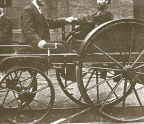
Early railway construction is often associated with the north of England, but there were notable early railways in the south. The Surrey Iron Railway (opened 1803), the Canterbury & Whitstable Railway, (1824), the London & Greenwich Railway (1836) and the London & Croydon Railway (1839) were all locally, rather than strategically, important, although the promoters of the last two might have had wider ambitions, with Dover and Brighton in mind respectively.
By the mid-1830s the potential of the railways as movers of people, as well as goods, was recognised, and lines from London to the towns of Dover, Brighton and Southampton were seen as worthy of investment. Only Dover and Brighton are relevant in this account of the construction and operation of the line from Hastings to Tonbridge, whence London could be reached on the South Eastern Railway's (SER) main line.

Dover was increasingly becoming established as the principal port for onward travel to France and Belgium in the first part of the nineteenth century, particularly since the ending of hostilities with France in 1815. In 1824 over 8,000 travellers made the voyage from Dover. The South Eastern Railway's assumption that cross-channel travellers were relatively affluent, and so more likely to be prepared to pay for the faster travel that the railways provided, was not mistaken. This was despite the vast improvement in the state of the roads brought about by the introduction of turnpikes in the 1820s. The SER's services between London and Folkestone commenced in 1843, and onwards to Dover in 1844.
Brighton already enjoyed the status of a fashionable resort early in the nineteenth century, helped by the royal connections with the Sino-Indian pavilion. The population of 24,000 in 1821 had risen to more than 40,000 in 1831 and travel to and from London by coach on the improved roads was buoyant, with 36 coaches plying the route in 1836, conveying 3,400 passengers in that year, some of whom were early long-distance commuters. The London & Brighton Railway was opened throughout in September 1841 and six trains daily ran in both directions.
Hastings lies roughly midway between Brighton and Dover. With a population of over 11,000 in 1841, although only a quarter of that of Brighton, Hastings was nevertheless a significant town, indeed the only town boasting a population exceeding 5,000 between Lewes and Hythe. The town was granted the status of a Cinque Port in medieval times but, like so many other Cinque Ports, there was a constant struggle against silting, compounded in the case of Hastings by more than one destructive storm. Apart from a large fleet of fishing boats launched from the beach, the town no longer had any great maritime links.
Like Brighton, Hastings was already a fashionable resort before the arrival of the railway. Entrepreneur James Burton (better




